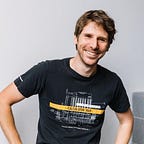Geotagging in the middle of the Pacific
When was the last time you were filling out a bank application and had to enter your coordinates in the form of latitude and longitude to a 20 metre accuracy? I’ll hazard a guess … never. However, every day Tupaia’s surveyors do just that — record remote Pacific Island clinic locations as part of their job. Our mission: to create an intuitive form field element that would allow tagging of locations without an Internet connection, without access to maps, in the middle of a multi-page survey. Challenge accepted.
Look and feel
In many of the locations we’re tagging you can forget about a reliable Internet connection. On top of that you can pretty much forget about accurate maps. Then, once you factor in that the geolocation question can appear pretty much anywhere in a survey (including between questions), there’s not much left to play with.
Tupaia Meditrak’s location field UI is simple, clean and follows the look and feel of all the text inputs that our surveyors are already used to.
Lock and load
Mobile phones in remote areas take a while to warm up and return accurate location data. The longer you wait the more accurate the signal gets (or so you hope). Ideally we prefer the accuracy to be under 20 metres however that’s not always possible — so there needs to be a way for a user to manually accept when they believe that the best possible accuracy has been reached.
Tupaia Meditrak’s UI displays the current latitude, longitude and accuracy and allows users to save the location when their desired accuracy is reached. If a surveyor accidentally navigates to a different question without saving, the location with its current accuracy is automatically saved.
Are you sure?
After a long day out in the field a surveyor may be able to recall whether a facility provides inpatient facilities or is known by any other names. A surveyor however is less likely to recall -8.25510496, 156.52866943. Therefore it’s important to make sure that once a location is saved it’s difficult to accidentally remove.
The location field uses a remove button that is small and difficult to hit coupled with a native mobile dialog boxes to confirm location removal. Trust us it works.
Behind the scenes
From the moment a surveyor begins to fill out a survey, we turn on the GPS and watch the location. This means that by the time the surveyor hits a location question the GPS is nice and warm and should begin delivering pretty accurate responses. The accuracy value, along with the coordinates, is sent to our servers during syncing so we know how precise each piece of location data is. Finally, when a survey is submitted, we send the current location of the surveyor as metadata to validate against location field values in future analysis.
Limitations are fun
I can imagine designing a location field for an app to be used in Australia. It’d be super jazzy with animated maps, a geocoder, maybe even some autocomplete options fading in and a shiny Google or Mapbox logo somewhere on screen. Designing apps for remote environments is not flashy but it makes you focus instead on creating a robust user experience. Sometimes it’s fun to focus on what a surveyor in a remote Pacific island is feeling whilst entering data than worrying about the frames per second of that animation of the rounded corner tooltip overlay that has just popped out of the marker in the centre of a 3D interactive map. Trust me, I’ve done both.
What is Tupaia Meditrak?
Tupaia Meditrak is a cross-patform (Android and iOS) React Native app that is helping collect a vast amount of data from clinics, health centres and hospitals in the Pacific region. Information such as whether there is a working fridge, how many beds there are, and whether the facility has been damaged in a recent disaster are all collected through the app and aggregated on dashboards at https://www.tupaia.org/. The App has some hardcore two-way syncing abilities so that our surveyors can use it in super-remote places whether there is internet connectivity is limited or altogether absent.
Interested in working with modern tech on a project that makes a positive social impact?
We have your dream job: https://angel.co/beyond-essential-systems-1/jobs/302493-full-stack-developer-for-social-impact-startup
